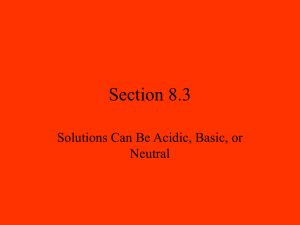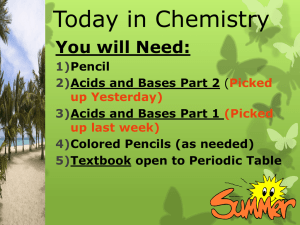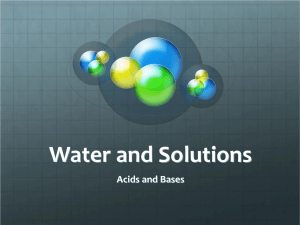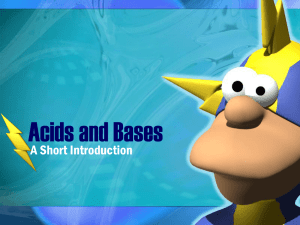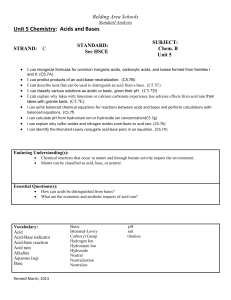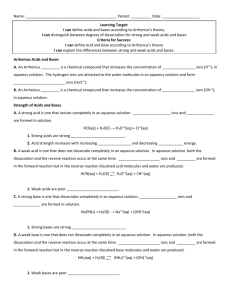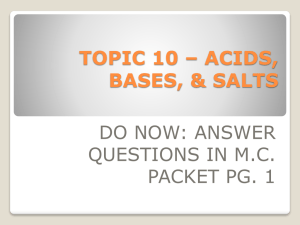Acids and Bases Worksheet: pH, Neutralization, and Acid Rain
advertisement
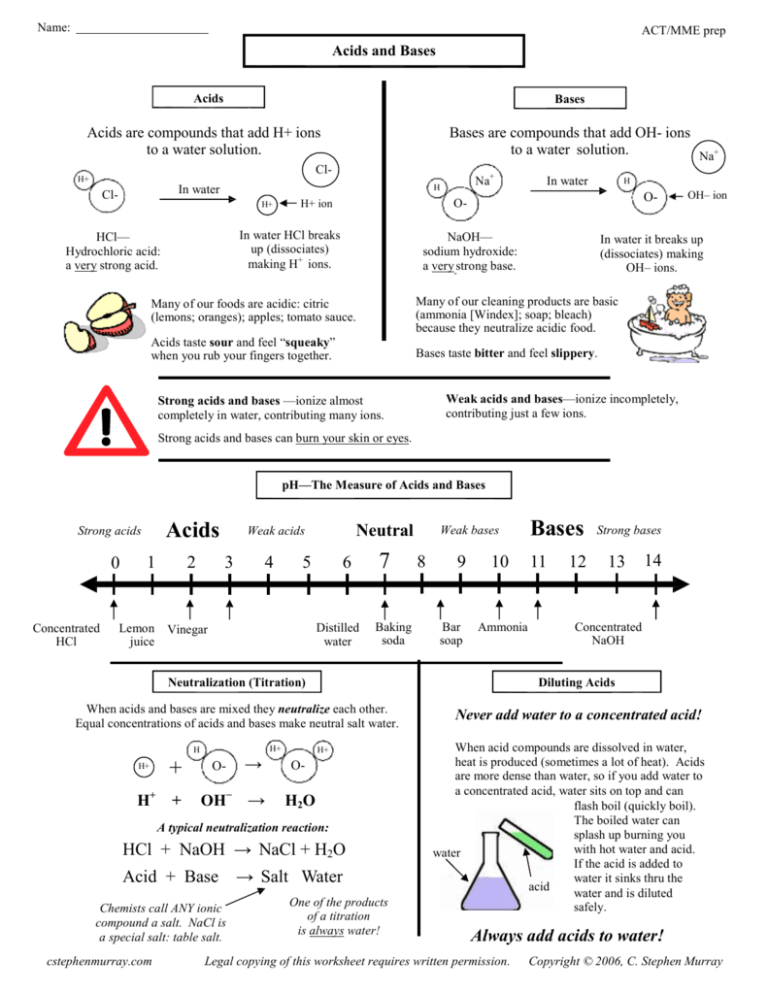
Name: ACT/MME prep Acids and Bases Acids Bases Acids are compounds that add H+ ions to a water solution. Bases are compounds that add OH- ions to a water solution. Na+ Cl- H+ Cl- Na+ H In water H+ H O- O- H+ ion In water HCl breaks up (dissociates) making H+ ions. HCl— Hydrochloric acid: a very strong acid. In water NaOH— sodium hydroxide: a very strong base. In water it breaks up (dissociates) making OH– ions. Many of our foods are acidic: citric (lemons; oranges); apples; tomato sauce. Many of our cleaning products are basic (ammonia [Windex]; soap; bleach) because they neutralize acidic food. Acids taste sour and feel “squeaky” when you rub your fingers together. Bases taste bitter and feel slippery. Strong acids and bases —ionize almost completely in water, contributing many ions. OH– ion Weak acids and bases—ionize incompletely, contributing just a few ions. Strong acids and bases can burn your skin or eyes. pH—The Measure of Acids and Bases Acids Strong acids 0 Concentrated HCl 1 Lemon juice 2 Neutral Weak acids 3 4 5 6 Distilled water Vinegar 7 Baking soda Weak bases 8 9 Bar soap 10 Ammonia Bases 11 12 Strong bases 13 14 Concentrated NaOH Neutralization (Titration) Diluting Acids When acids and bases are mixed they neutralize each other. Equal concentrations of acids and bases make neutral salt water. Never add water to a concentrated acid! H+ H H+ + H+ + O- → OH− → H+ O- H2O A typical neutralization reaction: HCl + NaOH → NaCl + H2O Acid + Base → Salt Water Chemists call ANY ionic compound a salt. NaCl is a special salt: table salt. cstephenmurray.com One of the products of a titration is always water! When acid compounds are dissolved in water, heat is produced (sometimes a lot of heat). Acids are more dense than water, so if you add water to a concentrated acid, water sits on top and can flash boil (quickly boil). The boiled water can splash up burning you with hot water and acid. water If the acid is added to water it sinks thru the acid water and is diluted safely. Always add acids to water! Legal copying of this worksheet requires written permission. Copyright © 2006, C. Stephen Murray Name: ACT/MME prep pH and Acid Rain Plants and animals need water close to neutral (pH 7) to survive. Acid rain also eats away statues and historical landmarks. Due to pollution from combustion reactions, rain today can be acidic. Raid less than pH 5.6 we call acid rain. The Roman ruins, the pyramids of Egypt, and other treasures of the world are being slowly dissolved away by acid rain. More damage has been done in the last century than in the last 2,000 years. Acid rain can kills plants, cause asthma and other physical problems. Without stopping pollution (and acid rain) these treasures may be lost forever. 1. Acid A. To mix acids and bases to cancel each other out and make salt water. 1. pH A. The measure of acids and bases. 2. Base B. A compound that adds H+ ions to water. 2. Salt Water B. A compound that adds a few OH– ions to water. 3. Neutral C. Any ionic compound. 3. Strong Acid C. To neutralize an acid with a base. 4. Neutralize D. Equal number of H+ and OH– ions; water is an example. 4. Weak Base D. The product of a neutralization reaction between an acid and a base. 5. Weak Acid E. A compound that adds a few H+ ions to water. E. A compound that adds OH– ions to water. 5. Acid Rain 6. A Salt F. A compound of sodium and chlorine. 7. Table salt G. When pollution causes rain to be acidic (pH of less than 5.6). 6. Titration F. A compound that adds a lot of H+ ions to water. Solution A (pH 4); Solution B (pH 2) Acid or Base? HCl H2(CO3) H3PO4 H2(SO4) NaOH LiOH Mg(OH)2 Ca(OH)2 HNO3 Acid or Base? Which one has more H+ ions? Which one has less OH– ions? Which one is more basic? Which one is more acidic? Solution A (pH 11); Solution B (pH 13) Has fewer OH– ions Has more OH- ions Which one has more OH- ions? Has more H+ ions pH of 0 to 7 Which one has less H+ ions? Feels squeaky clean pH of 7 to 14 Which one is more acidic? Has fewer H+ ions Feels slippery Which one is more basic? Tastes bitter Tastes sour Should you add an acid or a base? You need a pH of 6.2; you have a pH of 5.1. What is the product of every titration? Finish these neutralization reactions: (balance the salt, too). HBr + Mg(OH) → You need a pH of 12; you have a pH of 13.4. You need a pH of 7; you have a pH of 11.2. HS + Li(OH) → You need a pH of 4; you have a pH of 2.3. How do you safely dilute a concentrated acid? Antacids neutralize stomach acid. What is an antacid really?
